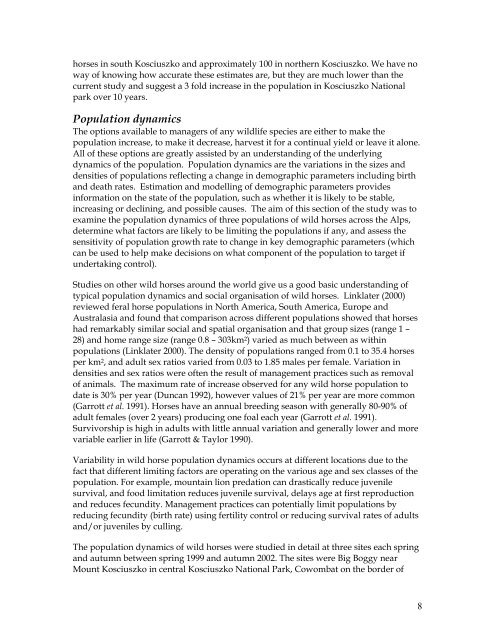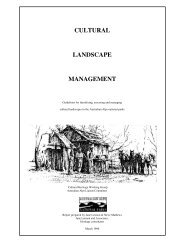The Population Ecology of Wild Horses in the Australian Alps
The Population Ecology of Wild Horses in the Australian Alps
The Population Ecology of Wild Horses in the Australian Alps
You also want an ePaper? Increase the reach of your titles
YUMPU automatically turns print PDFs into web optimized ePapers that Google loves.
horses <strong>in</strong> south Kosciuszko and approximately 100 <strong>in</strong> nor<strong>the</strong>rn Kosciuszko. We have no<br />
way <strong>of</strong> know<strong>in</strong>g how accurate <strong>the</strong>se estimates are, but <strong>the</strong>y are much lower than <strong>the</strong><br />
current study and suggest a 3 fold <strong>in</strong>crease <strong>in</strong> <strong>the</strong> population <strong>in</strong> Kosciuszko National<br />
park over 10 years.<br />
<strong>Population</strong> dynamics<br />
<strong>The</strong> options available to managers <strong>of</strong> any wildlife species are<br />
ei<strong>the</strong>r to make <strong>the</strong><br />
population <strong>in</strong>crease, to make it decrease, harvest it for a cont<strong>in</strong>ual yield or leave it alone.<br />
All <strong>of</strong> <strong>the</strong>se options are greatly assisted by an understand<strong>in</strong>g <strong>of</strong> <strong>the</strong> underly<strong>in</strong>g<br />
dynamics <strong>of</strong> <strong>the</strong> population. <strong>Population</strong> dynamics are <strong>the</strong> variations <strong>in</strong> <strong>the</strong> sizes and<br />
densities <strong>of</strong> populations reflect<strong>in</strong>g a change <strong>in</strong> demographic parameters <strong>in</strong>clud<strong>in</strong>g birth<br />
and death rates. Estimation and modell<strong>in</strong>g <strong>of</strong> demographic parameters provides<br />
<strong>in</strong>formation on <strong>the</strong> state <strong>of</strong> <strong>the</strong> population, such as whe<strong>the</strong>r it is likely to be stable,<br />
<strong>in</strong>creas<strong>in</strong>g or decl<strong>in</strong><strong>in</strong>g, and possible causes. <strong>The</strong> aim <strong>of</strong> this section <strong>of</strong> <strong>the</strong> study was to<br />
exam<strong>in</strong>e <strong>the</strong> population dynamics <strong>of</strong> three populations <strong>of</strong> wild horses across <strong>the</strong> <strong>Alps</strong>,<br />
determ<strong>in</strong>e what factors are likely to be limit<strong>in</strong>g <strong>the</strong> populations if any, and assess <strong>the</strong><br />
sensitivity <strong>of</strong> population growth rate to change <strong>in</strong> key demographic parameters (which<br />
can be used to help make decisions on what component <strong>of</strong> <strong>the</strong> population to target if<br />
undertak<strong>in</strong>g control).<br />
Studies on o<strong>the</strong>r wild horses around <strong>the</strong> world give us a good basic understand<strong>in</strong>g <strong>of</strong><br />
typical population dynamics and social organisation <strong>of</strong> wild horses. L<strong>in</strong>klater (2000)<br />
reviewed feral horse populations <strong>in</strong> North America, South America, Europe and<br />
Australasia and found that comparison across different populations showed that horses<br />
had remarkably similar social and spatial organisation and that group sizes (range 1 –<br />
28) and home range size (range 0.8 – 303km 2 ) varied as much between as with<strong>in</strong><br />
populations (L<strong>in</strong>klater 2000). <strong>The</strong> density <strong>of</strong> populations ranged from 0.1 to 35.4 horses<br />
per km 2 , and adult sex ratios varied from 0.03 to 1.85 males per female. Variation <strong>in</strong><br />
densities and sex ratios were <strong>of</strong>ten <strong>the</strong> result <strong>of</strong> management practices such as removal<br />
<strong>of</strong> animals. <strong>The</strong> maximum rate <strong>of</strong> <strong>in</strong>crease observed for any wild horse population to<br />
date is 30% per year (Duncan 1992), however values <strong>of</strong> 21% per year are more common<br />
(Garrott et al. 1991). <strong>Horses</strong> have an annual breed<strong>in</strong>g season with generally 80-90% <strong>of</strong><br />
adult females (over 2 years) produc<strong>in</strong>g one foal each year (Garrott et al. 1991).<br />
Survivorship is high <strong>in</strong> adults with little annual variation and generally lower and more<br />
variable earlier <strong>in</strong> life (Garrott & Taylor 1990).<br />
Variability <strong>in</strong> wild horse population dynamics occurs at different locations due to <strong>the</strong><br />
fact that different limit<strong>in</strong>g factors are operat<strong>in</strong>g on <strong>the</strong> various age and sex classes <strong>of</strong> <strong>the</strong><br />
population. For example, mounta<strong>in</strong> lion predation can drastically reduce juvenile<br />
survival, and food limitation reduces juvenile survival, delays age at first reproduction<br />
and reduces fecundity. Management practices can potentially limit populations by<br />
reduc<strong>in</strong>g fecundity (birth rate) us<strong>in</strong>g fertility control or reduc<strong>in</strong>g survival rates <strong>of</strong> adults<br />
and/or juveniles by cull<strong>in</strong>g.<br />
<strong>The</strong> population dynamics <strong>of</strong> wild horses were studied <strong>in</strong> detail at three sites each spr<strong>in</strong>g<br />
and autumn between spr<strong>in</strong>g 1999 and autumn 2002. <strong>The</strong> sites were Big Boggy near<br />
Mount Kosciuszko <strong>in</strong> central Kosciuszko National Park, Cowombat on <strong>the</strong> border <strong>of</strong><br />
8

















